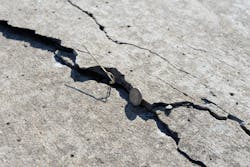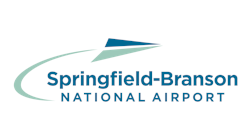Springfield-Branson National Airport (SGF) is undertaking its first airfield project in nearly ten years, reconstructing the north portion of one of their main taxiways, Taxiway U, and rehabilitating the south end. The airport’s funding and attention went to their new terminal, opened in 2009, during the ten-year period, with funds being put toward that terminal bond debt.
“We didn't do any airfield projects because we had invested so much in getting the ground ready and airfield in a position in which we could have a new terminal and previous airport administration set us up well in that regard. They got the airfield in good order knowing that we were going to be committed to maintaining the new terminal building,” explained David Schaumburg, SGF’s assistant director of aviation.
Come 2017, though, the pavement began to show its age with noticeable cracks forming in the taxiway due to alkali-silica reaction (ASR).
“My field maintenance folks and ops folks were making comments about that area of the airfield and how they were seeing a lot of cracking on the surface of taxiway uniform and really, it was breaking up a significant amount, showing a rapid deterioration likely due to ASR. A lot of swelling,” said Schaumburg.
Eventually, a large crack formed running lengthwise on Taxiway U, encompassing eight to 10 panels along the taxiway’s edge. The cracked portion of the taxiway was adjacent to about 450,000 square feet of cargo ramp space. Both UPS and FedEx utilize SGF. Yet, with airport funds tied up in terminal bond debt at the time, a large-scale replacement of the ruptured concrete was not feasible.
Working with engineering consulting firm Crawford, Murphy & Tilly, the airport was able to come up with some temporary solutions.
“They gave us some recommendations. We ended up doing a mill on that concrete. We did a four-inch mill and went back with two, two-inch lifts of hot mix asphalt just to buy us some time while we could do some programming,” said Schaumburg.
The following year, though, additional cracking began forming out outside of that asphalt patch and SGF ended up having to do another mill and fill to buy more time.
“It was certainly showing rapid deterioration, something that we were very nervous about, especially with all of our cargo operations going through that area and so, we had to get on it with doing design and knowing we had a big project that it was going to need to get programmed in,” Schaumburg recounts.
Able to free up funds to put towards their much-needed pavement repairs, the $7.29 million project began last year with Crawford, Murphy & Tilly coming in to perform a Pavement Management Plan (PMP) update – SGF’s first since the early 2000s.
“There've been a lot of changes between 2000 and today. A lot of pavements that didn't exist 20 years ago,” said Brian Hutsell, project manager, Crawford, Murphy & Tilly. “The PMP consisted of a visual inspection of the airfield pavements. We went there and walked all of the airfield pavements over the course of about two and a half weeks.”
The roadmap of pavement work needed indicated Taxiway U as needing the most attention and Hutsell said the team fast tracked aspects of the project because of its rapidly deteriorating condition.
“We did some surveys on Taxiway Uniform ahead of time to justify that project to the FAA to get funding a little earlier than the rest of these projects,” Hutsell said.
Ty Sander, vice president and aviation group manager, Crawford, Murphy & Tilly, said the project involved reconstructing a fourth of the taxiway’s pavement, including the connector to the end of the runway. “Which means we were having to reconstruct inside the runway safety area all the way up to the edge of the runway,” he said.
“The project also included rehabilitation of about another quarter of the parallel taxiway, where the pavement was in better condition than the area that was reconstructed, which consisted of, some small repairs, some panel removal and replacement, some joint replacement,” Sander continued. “We felt like there was enough remaining service life in the existing pavement that it made sense to rehabilitate that portion, versus reconstruct the whole thing..”
The work involved a 45-day closure of the runway used by both FedEx and UPS, requiring coordination with the tenants to ensure their operations continued smoothly as the work progressed.
“They both have daily flights that couldn't be interrupted. And so, we had to program the work in order to maintain those operations. We engaged with the stakeholders during the design and they were very helpful in modifying their operations and they honestly worked together really well in order to allow the construction to move forward as quickly and efficiently as possible,” said Sander.
Sander added that the work was phased to be more streamlined and reduce the amount of time that the runway was closed.
A unique aspect of the SGF project was the utilization of techniques that Crawford, Murphy & Tilly have been developing and testing at St. Louis Lambert International Airport (STL).
When an airport has thick, existing, concrete pavement that has to be removed and replaced, it must be replaced at approximately the current elevation so that it can tie into the pavements surrounding it, resulting in a lot of material to remove.
“The concrete isn't good enough to serve as a taxiway surface anymore, but there's a lot of intrinsic value still left in that material from a structural standpoint,” Sander described. “One of the things that we did is repurpose the concrete that was removed as a subbase layer at the bottom of the pavement structure. This creates a construction platform so that once you get that rubblized pavement in place, you've got some weatherproof ability built into your pavement structure that allows the rest of the construction to move forward. Even after you get a heavy rain, you've got a stable platform for the contractor to work on. It's also a good base that works as a part of the overall pavement design.”
Above the rubblized base is an open grated cement-treated aggregate, which has been employed at STL for 20 years, and was recently approved by the FAA to make the material available to airports across the country, said Sander.
“What that does is allow the pavements to basically drain all the water out of the sub grade. One of the primary things you learn in civil design school is having wet sub grades reduces the overall strength and durability of your pavements. So having this open grated sub grade really creates a funnel to get all the water that is underneath that taxiway out away from there, which we believe to greatly increase the service life of these types of pavements,” Sander described. “We're really excited about the ability to utilize that same technology in other locations, because it's been so successful in the place that it was tested.”
Out of the initial phases and tracking ahead of schedule, the project is moving into its next phase – the rehabilitation of the southern portion of the taxiway. The project is scheduled to be completed by Oct. 31 but will likely be completed sometime in the early weeks of Oct. if the project continues at the pace it has been.
“Barring no major weather delays or supply chain issues, there's a good chance we'll be a month ahead of schedule and maybe be done by early October,” said Schaumburg. “We've been very fortunate. We haven't had any big curve balls. I would attribute that likely to the fact that this is something that we had had planned and analyzed, had to put it on the shelf for a while, then were able to get it back off the shelf. We've had several opportunities to re-look at this and make sure we're addressing everybody's needs.”
Van Nuys
In March, the Van Nuys Airport (VNY) completed the design and construction of project for their Taxiway B project and began work on their Taxiway A project. The program was to reconstruct the 8000-foot-long asphalt Taxiway A and Taxiway B pavement including shoulders. The work also included widening of taxiway intersections to meet new design standards, upgrade of lighting with new LED taxiway centerline and edge lights, signage upgrades, new runway guard lights as well as other grading and drainage improvement.
Taxiway B’s budget was $29,722,000 and Taxiway A’s budget is $35,481,000.
Mark Vicelja, VNY’s senior airports engineer II, said planning for the projects began back in 2014, with the construction of Taxiway B starting in January of 2019 and the work on Taxiway A scheduled to be completed May 2021.
“The pavement was in various states of deterioration varying from excessive oxidation and d-cracking to rutting and full structural failure and spalling,” said Vicelja.
The program initially was anticipated to be designed and construction as three different projects over three years to optimize FAA federal funding. However, it was ultimately procured and constructed utilizing two separate construction packages – one for all of Taxiway B and one for Taxiway A, Vicelja detailed.
Ali Aoude, project engineer, HNTB, said the project began with data collection before the engineering team moved into the design phase.
“This entailed extensive research of historical data from past projects on the airfield, topographic survey within the project limits, and geotechnical investigation of both Taxiways A and B,” said Aoude. “From there, we dove straight into design, focusing on all aspects of the taxiway reconstruction. The scope included an upgraded taxiway geometry, full depth pavement reconstruction with a 20-year design life, grading and drainage improvements, upgraded LED lights and signs, and marking improvements.”
One of the main challenges of the program stemmed from both taxiways abutting existing lease holds and taxilanes, so maintaining access to the various leaseholds required breaking the construction into multiple smaller segments. Both taxiways also encroached into the main Runway 16R-34L safety area on the southern section of the airfield and, additionally, Taxiway B encroached into the smaller Runway 16L-34R safety area on the northern section of the airfield.
“The most critical factor we had to keep in mind was dividing the construction limits in such a manner to mitigate operational impacts to the airport. We had to be cognizant of the construction time frames and work area limits such that they would have the least impact to tenant operations and would always ensure ample access for aircraft to and from the runways. To address this, it was critical that we involved all stakeholders including airport operations and the tenants, so that we could fully understand the constraints and best accommodate the needs of all parties while limiting impacts to the airport,” said Aoude.
Vicelja said that LAWA Planning and Development staff, along with their design consultant, HNTB, held multiple meeting with the various affected tenant, airport users, airfield operations staff and the FAA to develop phasing plans and details to maintain access and mitigate operational impact prior to bidding the project.
Vicelja said that each phase of construction was carried out in as similar manner, beginning with closing the area to be reconstructed, the installation of lighted barricades, and the removal of airfield marking and signage leading into the work area. Temporary lighting and circuity were installed to maintain the electrical system for remaining active airfield areas prior to demolition of the existing pavement and electrical system.
“The existing pavement and electrical system are removed as well as the base and existing soil down to subgrade. The Contractor then installs deep utilities, such as electrical duct bank and storm drains, and starts construction of the taxiway base material and installs the in-pavement lighting conduit and base cans. The Contractor then completes installation of the asphalt pavement and installs the in-pavement taxiway and edge light fixtures, signage and tests the electrical system
“Finally, the contractor completes the pavement marking of the new taxiway and shoulder area, removes the barricades and opens the area up to aircraft operations. Once one phase is complete and access is restored, similar construction phase is then shut down and the process is repeated. VNY Airfield Operation staff coordinates all the closures and phasing changes closely with the FAA control tower and affected tenants ,” Vicelja continued.
“The construction process overall was consistent from phase to phase,” added Aoude. “Essentially, each work area began with milling of asphalt pavement, excavating down to subgrade, and demolishing existing utilities and structures that would be replaced. From there, the bulk of the work was preparing the subgrade, placing and compacting base material and laying down the final asphalt surface layers. Once the ductbanks and pavement was placed, the finishing touches included installation of new LED fixtures and signs, following by a new coat of marking.”
Aoude said that one of the unique factors of each project was temporarily shortening the runway and shifting the Runway Safety Area (RSA) in order to allow for construction that would have conflicted with the safe runway operations.
“As part of this, we had to consider the optimal weather times of the year for this shortening to occur to limit impacts to tenant operations and ultimately best accommodate aircraft performance. To accomplish this, we deliberately phased the runway shortening to be within the spring months to capture the best visibility and temperature conditions at VNY,” said Aoude.
During construction of each taxiway project, the runway was shortened and configuration was changed several times, involving displaced of runway thresholds, temporary visual flight approach system installation and new markings and lightings changes each time.
“All of the reconfigurations were successfully deployed, allowing us to keep the runway open during construction. This was a major accomplishment,” Aoude said.
Another challenge proved to be the weather
“One of the biggest challenges we faced early during construction of Taxiway B was a heavy rain season. The constant precipitation in the beginning of the year led to a four-week delay in the overall project schedule. To mitigate this, the design team reacted quickly and efficiently to re-sequence and combine certain phases of the project in order to recoup the time lost due to initial weather delays and maintain the original runway shortening window,” said Aoude.
Blue Grass
While most airports complete their airfield pavement projects over several months, Blue Grass Airport (LEX) opts for hours. The airport will close for 72 hours for its upcoming runway work, completing the entirety of the project in that time.
“A lot of our peer airports tend to close at night and perform incremental milling, paving and markings. We studied similar options. Our airport and local contractors have a successful history in weekend runway paving projects going back almost three decades. I was fortunate enough to be part of the last project, as a consultant, helping to manage the design of construction. Now, as part of the staff of this airport, I am putting that experience into practice as we prepare to close the facility again,” said Mark Day, director, development and facilities, LEX.
To accomplish the feat, LEX works with its airlines well in advance, and have notified them that in August 2021, the runway will be closed for repair.
“Then we bring in an army of asphalt staff and equipment,” Day said.
Some work is done in advance, such as removing in-pavement lighting, but otherwise most of the work will occur over one weekend – a sight to behold, said Day.
“During that weekend closure, the contractor will bring in multiple milling machines, mill it all off, truck all that material out of here. We expect to see four continuous paving trains working simultaneously. Materials will be fed from four asphalt plants located in our region. Over 20,000 tons of asphalt will be put down, followed by placement of the markings that the pilots need to see when landing. Further, we will see installation of new lighting, taking out the old incandescent fixtures, putting in new LEDs. When the facility is reopened to the public, it will look as if they are using a brand-new runway,” described Day.
The project was identified in LEX’s master plan, with planning and design beginning in 2016 and wrapping up this past spring, led by consultant HDR. As part of this phase, laser-based mapping and nondestructive testing was used to map out pavement cracks on the airfield.
“From that, the pavement condition index (PCI) ranged from 49 to 66 for different parts of the runway. We are starting to see conditions go below maintenance levels and are a strong candidate for rehabilitation. In the case of our runway, most of it consists of asphalt over concrete. Some of that concrete has been in place for about eight decades now and is intact. As the subsurface integrity is good, the project will consist of a mill and overlay of the asphalt layer on top,” said Day.
One aspect of the project will be smoothing portions of the runway profile, as the southern half is steeper than FAA standards for new airport construction.
“As we've continued to grow and serve larger aircraft over decades, the wingspans have increased, which means a future project may involve relocation of our primary parallel taxiway further away from the runway,” Day explained.
Though the most unique factor remains the 72-hour closure, which Day said offers a number of additional benefits.
“Primarily, we stretch the life of the asphalt. By placing it in one continuous paving operation, we reduce the number of joints. When you pave under short nightly closures, you introduce dozens of “cold joints” which are more susceptible to water and have shorter life spans. Asphalt is designed to bond strongly under high temperatures. Just as in our daily commute, we often see that the first place where cracks and potholes form is right along the paving joints between the driving lanes. We don't want that on our airfield. We have experienced a higher quality product, resulting in less maintenance and higher safety for the aircraft that operate here,” Day said.
“Every project is unique, and the best solution means taking into account the unique characteristics and needs of each airport,” said Tim Ward, project manager for HDR. “In this case, it meant a different construction phasing approach. It’s exciting to see it all come together.”
In addition to the safety benefits, LEX hopes to save on cost by executing the work all at once.
“Instead of weeks and weeks of short night closures and then trying to safely reopen the airport for traffic each morning, we can take about three months of paving down to three days by essentially letting the contractors have the airfield to themselves. It absolutely saves us time and reduces safety risks with respect to the requirements for opening and closing an airfield,” Day said.
Including two EMAS beds to be installed after the overlay, Day said that the project is estimated to cost around $44 million.
St. Pete-Clearwater International Airport
Like SGF, St. Pete-Clearwater International Airport (PIE) is completing its first pavement rehabilitation of their Runway 18-36 in over a decade to the tune of $25.6 million.
“The last pavement rehabilitation of Runway 18-36 was in 2008 and with 195 percent increase in air carrier passenger traffic in the past ten years, the pavement was showing signs of medium to severe distress for weathering, longitudinal and slippage cracking and depressions. Over the past three years, we have had to perform several emergency repairs on this runway,” said Tom Jewsbury, PIE’s airport director.
Planning for the project began in late 2017 with work beginning Nov. 2019 and expected to be completed Feb. of 2021.
“In order to rehabilitate pavement of our main runway while maintaining aircraft operations, the secondary runway, Runway 4-22, had to be extended by 100 ft to 6,000 ft to make it long enough for air carriers to continue to operate at PIE. This entailed close coordination with several departments of the FAA, Air Traffic Controllers, our air carriers, and tenants to ensure that impacts to airport operations were minimized,” said Jewsbury
The rehabilitation project will see air traffic temporarily shifted to noise sensitive communities and temporarily alter normal flight patterns. As a result, the airport reached out to local communities early on to educate them about the project and to inform them of this temporary use of Runway 4-22 for air carrier operation.
“A media campaign was also initiated prior to the closure of Runway 18-36 so the community was not caught by surprise and understood that this was a temporary shift of air carrier operations to Runway 4-22,” Jewsbury said.
And while it may impact their neighbors slightly in the short term, the project is much needed at PIE to enhance the safety of the facility to our aviation community and passengers and upgrade the runway to current FAA standards
“The project is unique because it could have drastically impacted the airport’s ability to support our air carriers, US Coast Guard, and other tenants if we were unsuccessful in getting approval to extend our secondary runway, Runway 4-22, by 100 ft to meet the minimum length for air carrier operations,” said Jewsbury. “If this would not have happened, the cost of the project would have been significantly higher as we would have had to construct at night and re-open the runway the next morning. But due to the extraordinary efforts of airport personnel and the engineer of record – Kimley-Horn – the team was able to work closely with the FAA to accomplish this task.”






